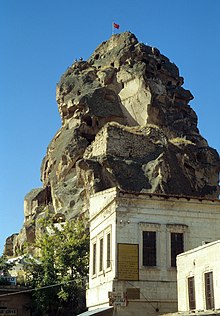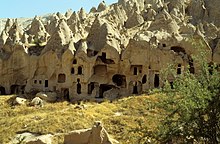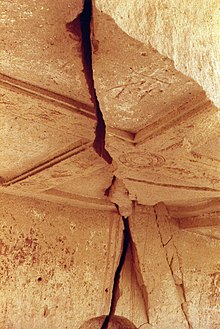
Cappadocia is a historical region in Central Anatolia, Turkey. It is largely in the provinces of Nevşehir, Kayseri, Aksaray, Kırşehir, Sivas and Niğde.

Nevşehir Province is a province in central Turkey with its capital in Nevşehir. Its adjacent provinces are Kırşehir to the northwest, Aksaray to the southwest, Niğde to the south, Kayseri to the southeast, and Yozgat to the northeast. Nevşehir includes the area called Cappadocia - a tourist attraction in Turkey. The town of Göreme is also located in Nevşehir.

Göreme is a town (belde) in the Nevşehir District, Nevşehir Province in Central Anatolia, Turkey. Its population is 2,034 (2022). It is well known for its fairy chimneys, eroded rock formations, many of which were hollowed out in the Middle Ages to create houses, churches and underground cities. Göreme was formerly known as Korama, Matiana, Macan and Avcilar.

Rock-cut architecture is the creation of structures, buildings, and sculptures by excavating solid rock where it naturally occurs. Intensely laborious when using ancient tools and methods, rock-cut architecture was presumably combined with quarrying the rock for use elsewhere. Though, in India and China, the terms cave and cavern are often applied to this form of man-made architecture, caves and caverns that began in natural form are not considered to be rock-cut architecture even if extensively modified. Although rock-cut structures differ from traditionally built structures in many ways, many rock-cut structures are made to replicate the facade or interior of traditional architectural forms. Interiors were usually carved out by starting at the roof of the planned space and then working downward. This technique prevents stones falling on workers below. The three main uses of rock-cut architecture were temples, tombs, and cave dwellings.

Vardzia is a cave monastery site in southern Georgia, excavated from the slopes of the Erusheti Mountain on the left bank of the Kura River, thirty kilometres from Aspindza. The main period of construction was the second half of the twelfth century. The caves stretch along the cliff for some five hundred meters and in up to nineteen tiers. The monastery was an important cultural center, a place of significant literary and artistic work.

Göreme Historical National Park is a national park in central Turkey. It occupies an area of nearly 100 km2 and is located in Nevşehir Province. It became a UNESCO World Heritage Site in 1985 under the name Goreme National Park and the Rock Sites of Cappadocia. The park features a rocky, water- and wind-eroded landscape with a network of ancient, interconnecting underground settlements.

Nevşehir is a city in the Central Anatolia Region of Turkey. It is the seat of Nevşehir Province and Nevşehir District. Its population is 123,882 (2022). It is 290 km (180 mi) from the capital Ankara and lies within the historical region of Cappadocia.
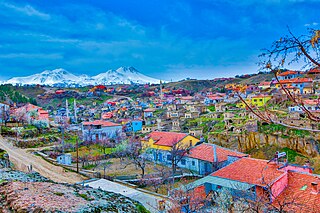
Ihlara, formerly known as Chliára is a town (belde) and municipality in the Güzelyurt District, Aksaray Province, Turkey. Its population is 2,289 (2021). It is situated at about 40 km (25 mi) from the province seat of Aksaray and near the town of Güzelyurt. The township is famed for the nearby valley of the same name, Ihlara Valley, which is a 16 km (10 mi) long gorge cut into volcanic rock in the southern part of Cappadocia, following several eruptions of Mount Erciyes. The Melendiz River flows through the valley.

Avanos is a town in Nevşehir Province in the Cappadocia region of Central Anatolia, Turkey, located 18 km (11 mi) north of Nevşehir, the capital city of the province. It is the seat of Avanos District. Its population is 14,968 (2022). Historically known as Venessa, modern Avanos stands on the banks of the longest river of Turkey, the Kızılırmak, the ancient Halys.
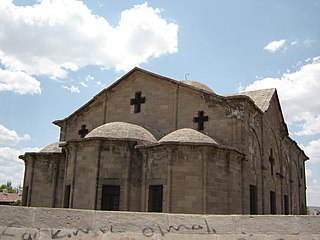
Derinkuyu is a town in Nevşehir Province in the Central Anatolia region of Turkey. It is the seat of Derinkuyu District. Its population is 10,912 (2022). The elevation is 1,333 m (4,373 ft).
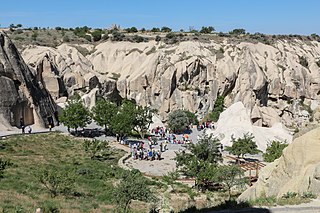
Göreme is a district of the Nevşehir Province in Turkey. After the eruption of Mount Erciyes about 2.6 million years ago, ash and lava formed soft rocks in the Cappadocia region, covering a region of about 20,000 square kilometres (7,700 sq mi). The softer rock was eroded by wind and water, leaving the hard cap rock on top of pillars, forming the present-day fairy chimneys. People of Göreme, at the heart of the Cappadocia region, realized that these soft rocks could be easily carved out to form houses, churches, and monasteries. These Christian sanctuaries contain many examples of Byzantine art from the post-iconoclastic period. These frescos are a unique artistic achievement from this period.
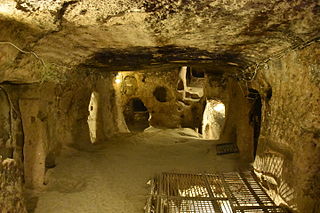
Kaymakli Underground City is contained within the citadel of Kaymakli in the Central Anatolia Region of Turkey. First opened to tourists in 1964, the village is about 19 km from Nevşehir, on the Nevşehir-Niğde road.

Derinkuyu (underground city) (Cappadocian Greek: Μαλακοπή Malakopi; Turkish: Derinkuyu Yeraltı Şehri) is an ancient multi-level underground city in the town of Derinkuyu in Nevşehir Province, Turkey, extending to a depth of approximately 85 metres (280 ft). It is large enough to have sheltered as many as 20,000 people together with their livestock and food stores. It is the largest excavated underground city in Turkey and is one of several underground complexes found throughout Cappadocia.

Cappadocian Greeks also known as Greek Cappadocians or simply Cappadocians are an ethnic Greek community native to the geographical region of Cappadocia in central-eastern Anatolia, roughly the Nevşehir Province and surrounding provinces of modern Turkey. There had been a continuous Greek presence in Cappadocia since antiquity, and the indigenous populations of Cappadocia, some of whose Indo-European languages may have been closely related to Greek, became entirely Greek-speaking by at least the 5th century.
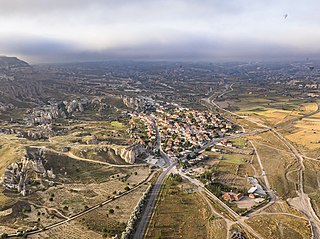
Çavuşin is a village in the Avanos District in Nevşehir Province in the Cappadocia region of Turkey. Its population is 421 (2022). It is on the road between Avanos and Göreme, about five kilometres north of Göreme. The older part of the village lies on and around a large ridge of tock visible for miles around. Most of the modern homes are closer to the main road where villagers were rehoused in the early 1960s amid fears that their old homes might collapse. Until recently Çavuşin was more or less ignored by tourism despite its proximity to the Göreme honeypot. However, in the 2010s more hotels opened in Cavuşin too, especially in the older part of the village.
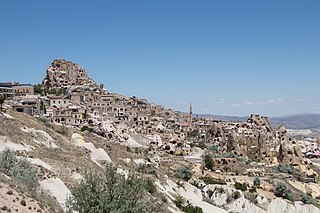
Uçhisar is a town (belde) in the Nevşehir District, Nevşehir Province in Cappadocia, Turkey. Its population is 3,555 (2022). It is 7 kilometres east of Nevşehir, 12 kilometres west of Ürgüp, and 10 kilometres south of Avanos.

The Ihlara Valley is a canyon which is 15 km long and up to 150 m deep in the southwest of the Turkish region of Cappadocia, in the municipality of Güzelyurt, Aksaray Province. The valley contains around 50 rock-hewn churches and numerous rock-cut buildings.
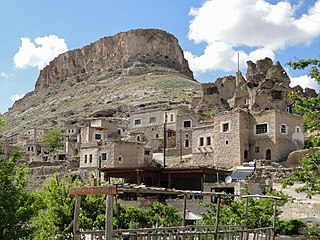
Soğanlı Valley, formerly known as Soandós is located in the Yeşilhisar district, Kayseri Province, Turkey, in the southeastern part of the region of Cappadocia. The valley contains several rock-cut churches and other rock-cut buildings, carved from the soft tuff stone of the Cappadocian landscape.
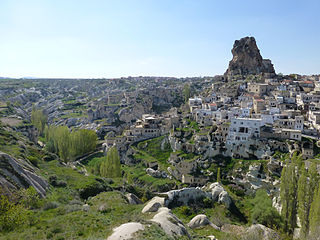
Ortahisar, previously known by its Byzantine name Potamía, is a town (belde) in the Ürgüp District, Nevşehir Province, Turkey. Its population is 3,086 (2022). Ortahisar is located about 20 km east of the provincial capital, Nevşehir.

Çanlı Kilise, meaning "bell church" or "church with a bell", is a Byzantine-era ruin site located about 15 km southeast of the city of Aksaray in Turkey. It consists of a large rock-cut settlement surrounding a prominent masonry church which lends its name to the whole site. A rare masonry church from the historical region of Cappadocia, the church is one of the best examples of Byzantine masonry architecture in central Anatolia and is frequently cited in textbooks on Byzantine architecture. Surrounding the church is a series of rock-carved houses carved into the south side of a hill over a distance of about one kilometer. Across the broad valley to the south, the peaks of Hasan Dağı are visible. Çanlı Kilise is accessible by a road winding its way from Akhisar, 4 km to the west on the plain below, up through a rugged hilly area en route to Çeltek, which is 6 km north of Çanlı Kilise on the same road.
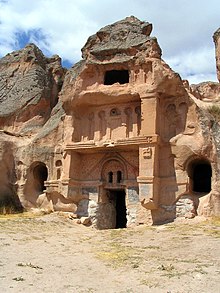
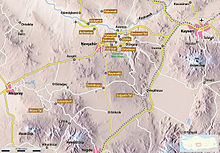
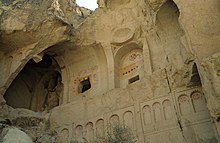

![Underground toilet in Guzelyurt [de] GuzelyurtToilette.jpg](http://upload.wikimedia.org/wikipedia/commons/thumb/9/93/G%C3%BCzelyurtToilette.jpg/220px-G%C3%BCzelyurtToilette.jpg)

